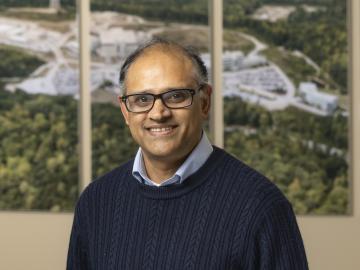
Filter News
Area of Research
- Biology and Environment (6)
- Electricity and Smart Grid (1)
- Energy Frontier Research Centers (1)
- Energy Science (31)
- Fuel Cycle Science and Technology (1)
- Fusion and Fission (14)
- Fusion Energy (3)
- Isotopes (2)
- Materials (27)
- National Security (6)
- Neutron Science (8)
- Nuclear Science and Technology (7)
- Sensors and Controls (1)
- Supercomputing (7)
News Topics
- (-) Biomedical (12)
- (-) Energy Storage (23)
- (-) Fusion (13)
- (-) Grid (19)
- (-) Nanotechnology (16)
- (-) Nuclear Energy (31)
- (-) Security (10)
- (-) Space Exploration (6)
- 3-D Printing/Advanced Manufacturing (25)
- Advanced Reactors (4)
- Artificial Intelligence (27)
- Big Data (11)
- Bioenergy (24)
- Biology (30)
- Biotechnology (6)
- Buildings (14)
- Chemical Sciences (24)
- Clean Water (6)
- Composites (9)
- Computer Science (37)
- Coronavirus (4)
- Critical Materials (7)
- Cybersecurity (12)
- Education (3)
- Emergency (1)
- Environment (46)
- Exascale Computing (15)
- Fossil Energy (2)
- Frontier (19)
- High-Performance Computing (33)
- Hydropower (3)
- Irradiation (2)
- Isotopes (17)
- Machine Learning (15)
- Materials (59)
- Materials Science (26)
- Mathematics (2)
- Mercury (3)
- Microelectronics (2)
- Microscopy (12)
- Molten Salt (5)
- National Security (21)
- Neutron Science (42)
- Partnerships (24)
- Physics (23)
- Polymers (9)
- Quantum Computing (12)
- Quantum Science (12)
- Simulation (29)
- Software (1)
- Summit (11)
- Transportation (25)
Media Contacts

Tristen Mullins enjoys the hidden side of computers. As a signals processing engineer for ORNL, she tries to uncover information hidden in components used on the nation’s power grid — information that may be susceptible to cyberattacks.

Creating energy the way the sun and stars do — through nuclear fusion — is one of the grand challenges facing science and technology. What’s easy for the sun and its billions of relatives turns out to be particularly difficult on Earth.

Scientist-inventors from ORNL will present seven new technologies during the Technology Innovation Showcase on Friday, July 14, from 8 a.m.–4 p.m. at the Joint Institute for Computational Sciences on ORNL’s campus.

An advance in a topological insulator material — whose interior behaves like an electrical insulator but whose surface behaves like a conductor — could revolutionize the fields of next-generation electronics and quantum computing, according to scientists at ORNL.

Like most scientists, Chengping Chai is not content with the surface of things: He wants to probe beyond to learn what’s really going on. But in his case, he is literally building a map of the world beneath, using seismic and acoustic data that reveal when and where the earth moves.

ORNL scientists found that a small tweak created big performance improvements in a type of solid-state battery, a technology considered vital to broader electric vehicle adoption.

Having passed the midpoint of his career, physicist Mali Balasubramanian was part of a tight-knit team at a premier research facility for X-ray spectroscopy. But then another position opened, at ORNL— one that would take him in a new direction.

ORNL will team up with six of eight companies that are advancing designs and research and development for fusion power plants with the mission to achieve a pilot-scale demonstration of fusion within a decade.

Nature-based solutions are an effective tool to combat climate change triggered by rising carbon emissions, whether it’s by clearing the skies with bio-based aviation fuels or boosting natural carbon sinks.

As renewable sources of energy such as wind and sun power are being increasingly added to the country’s electrical grid, old-fashioned nuclear energy is also being primed for a resurgence.


